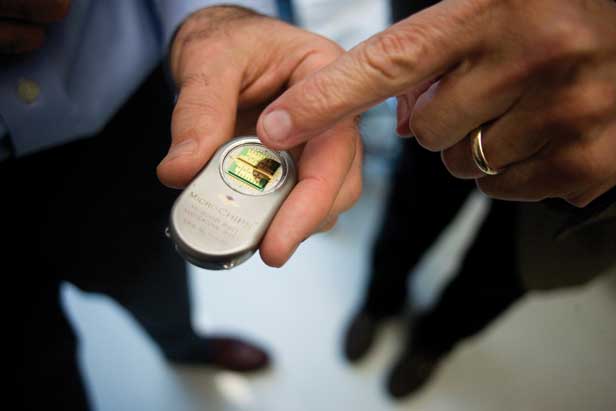
About 15 years ago, MIT professors Robert Langer and Michael Cima had the idea for a programmable, wirelessly controlled microchip that would be implanted in a patient’s body to deliver drugs. In February, the MIT researchers and scientists from MicroCHIPS, a company based in Waltham, Massachusetts, reported that they successfully used such a chip to administer daily doses of an osteoporosis drug normally given by injection.
The results represent the first successful test of such a device and could ultimately allow doctors to remotely control delivery of their patients’ drugs, says Langer, an Institute Professor of chemical engineering and biological engineering. With the ability to load different drugs and release them as needed, “you could literally have a pharmacy on a chip,” he says.
The programmable chips (pictured above) could dramatically change treatment not only for osteoporosis but also for many other diseases, including cancer and multiple sclerosis.
The MIT research team started working on the implantable chip in the mid-1990s. John Santini, PhD ’99, then a University of Michigan undergraduate visiting MIT, took it on as a summer project under the direction of Cima and Langer. Santini, who returned to MIT as a graduate student to continue the project, is also an author of the new paper, published in Science Translational Medicine.
MicroCHIPS, which was founded in 1999 and licensed the microchip technology from MIT, oversaw the clinical trial, which began in Denmark in January 2011. In the study, seven women aged 65 to 70 received the osteoporosis drug teriparatide through chips implanted during a 30-minute procedure carried out under local anesthetic at a doctor’s office. The chips remained in place for four months.
Dosages can be scheduled in advance or triggered remotely by radio communication over a special frequency called the Medical Implant Communication Service (MICS). The study found that doses delivered by the device were absorbed, distributed, and metabolized just like injected drugs, and there were no adverse side effects.
“Compliance is very important in a lot of drug regimens, and it can be very difficult to get patients to accept a drug regimen where they have to give themselves injections,” says Cima, a professor of engineering. “This avoids the compliance issue completely, and points to a future where you have fully automated drug regimens.”
Keep Reading
Most Popular
Large language models can do jaw-dropping things. But nobody knows exactly why.
And that's a problem. Figuring it out is one of the biggest scientific puzzles of our time and a crucial step towards controlling more powerful future models.
The problem with plug-in hybrids? Their drivers.
Plug-in hybrids are often sold as a transition to EVs, but new data from Europe shows we’re still underestimating the emissions they produce.
Google DeepMind’s new generative model makes Super Mario–like games from scratch
Genie learns how to control games by watching hours and hours of video. It could help train next-gen robots too.
How scientists traced a mysterious covid case back to six toilets
When wastewater surveillance turns into a hunt for a single infected individual, the ethics get tricky.
Stay connected
Get the latest updates from
MIT Technology Review
Discover special offers, top stories, upcoming events, and more.